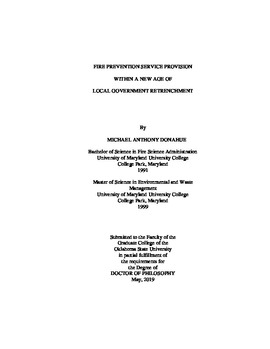| dc.contributor.advisor | Hendershot, Marcus E. | |
| dc.contributor.author | Donahue, Michael Anthony | |
| dc.date.accessioned | 2019-10-25T19:02:51Z | |
| dc.date.available | 2019-10-25T19:02:51Z | |
| dc.date.issued | 2019-05-01 | |
| dc.identifier.uri | https://hdl.handle.net/11244/321515 | |
| dc.description.abstract | This dissertation examines the effects of the Great Recession on the provision of fire prevention services by local government fire departments in the United States. Fire prevention is integral to community fire protection and equally important as emergency response. Anecdotal evidence at the time indicated that fire prevention program cuts were among the first made by fire departments. This exploratory study utilizes data from a nonrepresentative convenience sample of fire prevention providers who responded to the Vision 20/20 Fire Prevention Cuts Survey in 2012 regarding the effects of the Great Recession. Recurrent economic downturns keep this topic relevant given the pervasive financial stress faced by local government. The study first developed a common method of comparing fire prevention programs across communities. This method is informed by the literature on public cutback budgeting and uses an ordinal index based on the locus of budgetary control. It was applied to score different community-based provision schemes for plan review, new construction inspection, existing building inspection, public education and fire-arson investigation services. Higher index scores are associated with these services being consolidated under the fire department. Lower scores are associated with fewer services provided by multiple entities. Analysis showed that larger communities protected by career-oriented fire departments tend to concentrate provision of all five services under the local fire department, while smaller communities protected by volunteer-oriented departments tend to spread out provision among different entities or not provide some services. Analysis in the second part of the research found that departments in these larger communities were also the most likely to make budget cuts to fire prevention. This implies that larger populations proportions will face increased fire risk during retrenchment. The last part of this study examined cutback strategies. Results indicated that across the board cuts predominate at the department level, but that there are clear preferences within fire prevention to cut existing building inspections before other services. Short-term budget balancing approaches in the form of personnel cuts are universal regardless of cut depth. However, many departments also apply longer-term strategies to lessen the impact on those two services. | |
| dc.format | application/pdf | |
| dc.language | en_US | |
| dc.rights | Copyright is held by the author who has granted the Oklahoma State University Library the non-exclusive right to share this material in its institutional repository. Contact Digital Library Services at lib-dls@okstate.edu or 405-744-9161 for the permission policy on the use, reproduction or distribution of this material. | |
| dc.title | Fire Prevention Service Provision Within a New Age of Local Government Retrenchment | |
| dc.contributor.committeeMember | Brienen, Marten W. | |
| dc.contributor.committeeMember | Clark, Burton A. | |
| dc.contributor.committeeMember | Fullerton, Jami A. | |
| osu.filename | Donahue_okstate_0664D_16123.pdf | |
| osu.accesstype | Open Access | |
| dc.type.genre | Dissertation | |
| dc.type.material | Text | |
| dc.subject.keywords | budgeting | |
| dc.subject.keywords | cutback | |
| dc.subject.keywords | fire department | |
| dc.subject.keywords | prevention | |
| thesis.degree.discipline | Fire and Emergency Management Administration | |
| thesis.degree.grantor | Oklahoma State University | |
